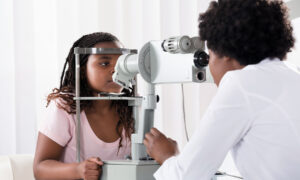May 1, 2020
By Jack L. Schaeffer, OD, FAAO
 In my optometric career, I have always believed in differentiating my practice by offering specialty services that other practitioners choose not to provide either because these services are perceived to be too complicated or time consuming. Practices that provide specialty services are often more profitable as well. Let me illustrate my point with the following hypothetical practices:
In my optometric career, I have always believed in differentiating my practice by offering specialty services that other practitioners choose not to provide either because these services are perceived to be too complicated or time consuming. Practices that provide specialty services are often more profitable as well. Let me illustrate my point with the following hypothetical practices:
Example One
- one-doctor practice with 5 percent of annual revenue spent on advertising
- office open 5.5 days a week
- patient care 4.5 days a week (approximately 4,000 patients -18 per day)
Revenue:
- comprehensive and contact lens exams – 15 percent
- contact lens materials – 15 percent
- medical billing – 15 percent
- optical sales – 55 percent
- no fee for service
Total revenue: $1 million
Net: $250,000
Example Two
- one-doctor practice with 2 percent of annual revenue spent on advertising
- office open 4.5 days a week
- patient care 3.5 days a week (approximately 2,800 patients -16 per day)
Revenue
- comprehensive and contact lens exams – 15 percent
- contact lens materials – 20 percent
- medical billing – 15 percent
- fee for service – 15 percent
- optical sales – 35 percent
Total revenue: $1 million
Net: $300,000+
Specialty practices, including myopia management practices, have higher net percentages due to higher average revenue per patient and lower cost of goods. Both models can provide excellent eye care, but I believe practitioners can provide more comprehensive eye care in a practice that offers specialty services.
COVID-19 has created an upheaval in our business models. Specifically, professional fees will be reduced by telemedicine, and optical/contact lens sales will be lost to the internet channel, perhaps permanently. However, if you embrace a specialty eye care model, you have many options to come back stronger than ever.
Myopia management is a specialty that can truly differentiate your practice, improve revenue, and provide care that pediatric myopes deserve. The prevalence of myopia and high myopia is increasing in the U.S. and globally at an alarming rate, with significant increases in the risks for vision impairment from pathologic conditions associated with high myopia, including retinal detachment, myopic macular degeneration, cataract, and glaucoma.
According to estimates, over one-third of the world’s population is myopic, and by 2050, almost half will be myopic … a staggering five billion people. Worse yet, by 2050, over one billion people are expected to have high myopia. In the U.S., for children and teenagers aged 5 to 19 years, the overall prevalence of myopia (-1.00D and higher) is estimated to be a shocking 42 percent.
The fee-for-service specialty practice is the practice of the future. Dermatology, plastic surgery, and dentistry have all recognized and adopted the value of adding out-of-pocket services to enhance patients’ lifestyle and health. Ophthalmology has embraced specialty intraocular lenses to be a part of the fee-for-service medical model philosophy.
Optometrists have so many opportunities to embrace this fee-for-service model: sports vision, low vision, vision therapy, dry eye, and myopia management. In my view, myopia management offers the most significant opportunity, both financial and medical, of all these specialty services.
However, myopia management may be viewed as a threat to many eye care professionals because it is unfamiliar. Incorporating it into a primary care practice will require changing clinical protocols, modifying appointment schedules, updating fee schedules, adding new equipment, and retraining staff. When faced with a pediatric progressive myope, most eye care practitioners play it safe, add another -0.50 DS to the child’s prescription, and tell the parents to bring the child back in one year for another eye exam. Nothing is prescribed to slow the progression of myopia.
As a busy professional, you must determine what level of myopia care is best suited for you and your practice. In my experience, there are three models of myopia management from which to choose:
1) education and referral to a qualified colleague
2) education, basic myopia management, and referral of complicated cases to a qualified colleague
3) comprehensive myopia management
With so many myopia treatment options available that have demonstrated efficacy, optometrists have a professional responsibility to make a choice of which model of myopia care best suits their personal and practice philosophy.

Jack L. Schaeffer, OD, FAAO, is the founder of an 18-location group practice and a refractive laser center and recently authored a miniseries on the history of contact lenses and the contact lens specialty practice. He currently is a board member and fundraising chairman for Optometry Cares: The AOA foundation and the GPLI institute.













